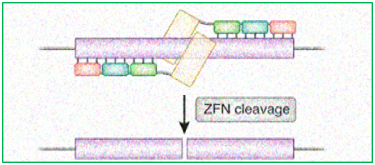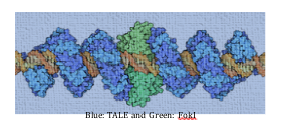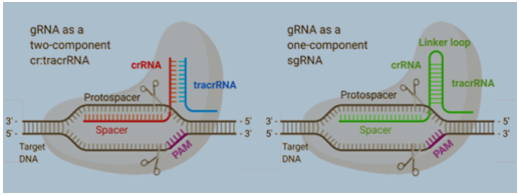$20 Bonus + 25% OFF CLAIM OFFER
Place Your Order With Us Today And Go Stress-Free
Gene editing is trending these days. A revolution in Biology, that has all the potential to cure the suffering. All thanks to the technology, that led to this magnum opus in the field of Genomics. The birth of Genomics was laid down in the experiments of Mendel.
The scientific community today is well aware of Mendel, the father of Genetics, who called the hereditary units as cell elements. After 25 years of his death, Wilhelm Johansen, in 1909 named the hereditary unit with a catchier word, the gene.
From then on, genes have become the fundamental concept in biological sciences and caught the interest of many researchers. Discoveries unravelled many fascinating details about genes, which slowly extended the development of genetics into an offshoot in the field of biology, Genomics.
Genomics and Genetics are usually confused. Genetics is all about the heredity of genes and their variation. Genomics is the study of genes.
Important periods and events in the development of Genomics:
Genomics started with DNA sequencing in 1970, whose data shed light on the structure and functioning of a gene. The years before 1970 saw the discovery, genetic nature, composition, structure of DNA and also the central dogma of life.
After the 1970s, technological advancements have driven genomics to its present status. The techniques like Polymerase chain reaction (PCR) and Gene sequencing, have progressed the deciphering of the entire genome of microbes. These events have set the stage for the Mapping and Sequencing of the entire Human Genome.
The status of Genomics is further fuelled to newer miles with the automation and computing power of supercomputers. From then on, there has been a data explosion on the genetic information available, which is being stored securely in databases. This information helps us study biological problems at a level never possible before.
(1970) – Frederick Sanger – First DNA sequencing methods.
(1985) – Kary Mullis – PCR technology.
(1986) – Automation of DNA sequencing
(1990 - 2003) – Human Genome Sequencing
(2002) – Large amounts of genomic data were made to public access through databases.
(2005) – Next Generation Sequencing – Increase in the speed of Sequencing 70-fold.
(2007) – CRISPR role in immunity of bacteria against viruses.
(2008) – Genomics bore its almighty fruit – The hotspots of cancer in the Gene sequence and druggable targets were realised. This led to personalized medicine approaches.
(2010) – Publication of the first Neanderthal genome.
(2013) – CRISPR as a gene editing tool.
(2020) – SARS CoV-2 genome sequenced.
The following are the key areas, where Genomics will have a major impact:
Medicine and Health Care: Therapies have changed and are becoming centred towards gene sequencing information. Treatment, Prevention, and curing are skewed specifically to the genome of the person.
Agricultural and Animal Sciences: Conventional breeding involved trial and error to develop a breed. With Genomics in hand, better breeds are developed based on the trait and sequence information, which also involves much statistics. Rather than breeding and selection of a breed, for a longer period, the genomic data reduces this to a much shorter span of time, which involves prediction through statistical analysis. This has already proven to be a successful attempt.
Metagenomics: The previous sequencing of microbes was only from cultures. Metagenomics is a new branch in the field of genomics and involves the sequencing of Microbial genomics obtained from natural habitats, this opened doors to a hidden diversity of genes, which has potential applications in remediation and restoration.
Forensics and Crime Science: Electrophoresis, Molecular markers, and Sequencing technology enabled the investigations to focus towards the key element DNA. This has a very positive impact on criminal justice.
The above points proclaim the importance of Genomics in the field of Biology. Genomics Assignment Help provides a foundation to help Australian students connect the dots from the basics to advanced topics in Genomics.
Apart from Genomics Assignment Help, we provide help with the various domains of biology.
Zoology: Zoology is the study of animal life. It encompasses the geographical distribution, structural, physiological, and behavioural aspects and also the classification of animals.To know more, click on Zoology Assignment Help.
Biochemistry: Biochemistry is an integrated science of Biology and chemistry. The study includes the chemistry of living organisms, and their metabolism, that make the organism living.Get Biochemistry assignment help from our experts.
Molecular Biology: The study of this discipline encompasses the synthesis, interactions, and functional, structural elements of living molecules, including Proteins, Carbohydrates, lipids, and Nucleic acids.
Microbiology: It is the science of microbes. This study includes the structural, functional, and evolutionary aspects along with the classification of microbes.
To know more, click on Microbiology Assignment Help.
Biotechnology - Study Of technology in biology to produce useful products is called biotechnology . Get more information and assignment help in biotechnology for scoring top grades.
The word Genomics is a confluence of the two terms: Gene – the hereditary unit and omics – the complete constituents.
Genomics deals with the study or analysis of all the genes of an organism. This study includes the structure, function, evolution, expression, interaction, mapping, and editing of genes.
Genomics is a multi-disciplinary approach. We understand genes through several branches of Biology.
These branches can be split into two types.
Traditional Sciences (Mendelian Genetics, Cytogenetics, Population Genetics, biochemistry).
Modern Sciences (Molecular Biology, Bioinformatics, Robotics (allows AI and computation to take over complicated tasks).
Based on how we study the genes, the branch of Genomics is categorised into three branches.
Structural Genomics:
Organisation and sequence of DNA of genes
Mapping and sequencing (structure) are dealt with.
The sciences that help are Molecular Biology, Mendelian Genetics, bioinformatics, and robotics.
Functional Genomics:
Function of genes
Function, expression [at all levels – mRNA (transcriptomics) and proteins (Proteomics)], interactions (Protein–Protein and Protein – DNA), and editing of genes are dealt with.
The sciences that help are Molecular Biology and Bioinformatics.
Comparative Genomics:
Genes of different organisms of the same species and different species are compared to find similarities and dissimilarities, and the function of other unknown genes This study has potential applications in agriculture and medicine.
Evolution, function, and interactions of genes can be interpreted.
The sciences that help are Bioinformatics, Robotics and Biochemistry.
Genomics Assignment Help can break down complex topics into readable, simpler topics. Contact us now, we will handle your assignments with excellence.
Here is one of the complex topic that our experts made readable and simpler:
Gene Editing, Tools:
Revolution in curing genetic diseases/abnormalities started with Gene Therapy in 1990. Gene Therapy supplements the functions of abnormal genes, through the therapeutic stem cells, with normal genes.
Gene editing technology started by the end of the 20th century, reached its full potential by 2015. Gene editing doesn’t supplement the functions of an abnormal gene but tries to rectify the abnormal gene. Rectification can be achieved through editing, modification, or deletion of the targeted gene.
Whatever the technology of Gene Editing, they all rely on inducing a Double Stranded Break (DSB) by programmed nucleases. DSBs are specific cuts at desired locations in the DNA. The cell has its own machinery to repair the induced DSB. Non-homologous end-joining (NHEJ) and Homologous-directed Repair (HDR) are the two ways in which DSB can be repaired.
NHEJ is imprecise and involves a range of proteins, that try to join the two broken ends of the DNA. This might involve some random insertions or deletions.
HDR is precise and uses a homologous copy of DNA (Donor Template) to correct the DSB.
Three frequently used tools that are used in gene editing technology include:
|
Gene Editing Technology |
Expansion |
|
ZFN |
Zinc Finger Nucleases |
|
TALENs |
Transcription Activator Like Effector Nucleases |
|
CRISPR |
Clustered Regularly Interspaced Short Palindromic Repeats |
Zinc Finger Nucleases (ZFN):
Zinc Finger Nucleases are programmable restriction endonucleases. The two important components of ZFN are DNA binding Zinc finger domains and DNA-cutting domains.
DNA binding ZFNs can be modified artificially (programmed) to bind to target sites of the DNA. DNA cutting domains make cuts at the target sites.

The cuts are repaired by the cellular mechanisms, discussed above. For us to make a precise repair, along with ZFNs we add a donor DNA to generated DSB.
Transcription Activator Like Effector Nucleases (TALENs):
The TALEN technology uses two protein domains. TALE and FokI. TALE is DNA specific protein binding domain that resembles a transcription factor in function and structure, thus is the name Transcription Activator Like Effector (TALE). TALE is the programmable portion of TALEN.
FokI is an endonuclease, that requires prior binding of TALE to the DNA. FokI induces DSB.

As said before, the DSB’s are repaired. HDR requires a Donor DNA template.
CRISPR-CAS 9:
CRISPR-CAS9 system was reported as an immune system in bacteria, against bacteriophages in 2007 and later transformed into a gene editing technology in 2015.
CRISPR (Clustered Regularly spaced short palindromic repeats) is a family of DNA sequences in lower microbes, the Bacteria and Achaea. These heritable sequences confer adaptive immunity to the bacteria and degrade the incoming viral RNA and DNA in bacteria.
When a phage infects a bacterium, the viral DNA is processed into pieces called protospacers (pS). The pS are inserted into the CRISPR locus. CRISPR locus has many direct palindromic repeats (shown in pink). pS are termed as Spacers (S), shown in green, once are inserted into the CRISPR locus. Each S is bound by palindromic repeats. CRISPR locus, therefore, serves as a record for the entry of many types of viruses that infect the bacteria.
When the same phage infects the bacteria the other time, the CRISPR-CAS system is activated to interfere with the viral replication. There is a region in bacterial DNA known as CRISPR-Cas Locus. This locus codes for a Cas system.

The Cas system has two components. A Cas protein and Guide RNA (gRNA).

The gRNA can come in two forms. The brown representation in the above figure is the Cas protein.
|
Forms of gRNA |
Components |
|
Two Component gRNA (Red and Blue) |
A crRNA (CRISPR RNA) and |
|
One Component gRNA (Green) |
crRNA and tracrRNA linked by linker loop |
Cas Protein: Nuclease
crRNA: RNA of spacer and tracrRNA: Structural RNA, enhances the precision of Cas Protein.
The crRNA is complementary to the protospacer, whose adjacent motif is PAM (Protospacer Adjacent Motif). The Cas system binds to the target DNA and cleaves at the PAM site, creating DSB.
CRISPR is manipulated by programming the crRNA because crRNA has the ability to recognise the target sites.
The next thing that follows is the repair of DSB, which can happen in either of the two ways mentioned earlier.
Also Read - University Assignment Help
1. Polymerase Chain Reaction (PCR) steps:
PCR is a technology that helps amplify the gene of interest / desired gene from nanomoles to millimoles.
PCR was developed in 1980 by Kary Mullis. PCR relies on an enzyme termed DNA polymerase. DNA polymerase uses a DNA as template and makes a billion copies of it. Taq polymerase is generally used to synthesise new DNA templates because it can operate at high temperatures.
The important ingredients in PCR include:
Gene/DNA template
Buffer solution
2 Primers (5’ – 3’) for two strands.
dNTPs (dATP’s, dTTP’s, dCTP’s and dGTP’s)
Taq Polymerase (Thermo aquaticus (taq) – the source of this enzyme).
PCR is a cycle and happens in three steps.
Denaturation – 94-95 (At high temperature, the double-stranded DNA is separated into two individual single strands).
Annealing – 50-56 (To the single strands of DNA, primers get attached). The primer that attaches to the 3’ – 5’ strand is known as Forward primer and the primer that attaches to the 5’ – 3’ strand is known as Reverse Primer.
Extension - 72 (Polymerase extends the 3’ sides of primers. The 5’ side of dNTP’s are added to the 3’ side of primers. The extension goes on till the formation of double-stranded DNA is complete.
After Step 3, the newly formed DNA are cycled back to Step 1. PCR reactions are driven in an automated machine called as Thermocycler, that provides, appropriate temperatures for the individual steps. This cycling PCR can produce billions of DNA copies from hundreds of DNA.
2. Genome and Types of Genome:
The complete set of DNA of an organism is known as Genome.
Genomes can be categorised into two.
Prokaryotic Genomes
Eukaryotic Genomes
Eukaryotic Genomes can be further categorised into three.
Nuclear Genome: The complete set of chromosomes seen in a nucleus.
Chloroplast Genome: Chloroplasts are semi-autonomous organelles, majorly found in plants. The semi-autonomist character is attributed to the plasmid of the chloroplast. This plasmid is the Chloroplast genome.
Mitochondria Genome: Mitochondria are also semi-autonomous like Chloroplasts. The plasmid of Mitochondria forms the Mitochondrial Genome.
Do you find it challenging to grasp the concepts of Genomics? Look no further! Our experts assist you in mastering the subject and leading you towards success. With their profound knowledge and expertise, they have supported numerous Australian students in excelling the Genomics concepts.
Our Academic expert Chris, M.sc in Human Genomics has advanced knowledge in Genomics. His passion for teaching makes him one of the best teachers we have onboard. This reputed academician has trained many Australian students in acing the concepts of Genomics.
John Brett, the subject expert is a master at making notes, to the point, crisp and short. His assistance will help you solve real-world problems and make your subject learning oriented towards the real-life world.
Don’t miss this opportunity to learn from academic professionals and experts in Genomics Assignment Help.
Sharpen your knowledge in Genomics by practising our free sample papers! Solve the real exam-style questions and gain confidence in your understanding of the subject. We offer a wide range of downloadable, high-quality, sample papers, designed to ace the subject.
|
|
|
|
Also Read - Care Skills For Parkinson’s Disease
The following tips are essential to write an effective Genomics assignment.
Understand the Assignment: Read the instructions carefully given in the assignment. Note all the requirements and identify the key factors your assignment should be built on.
Collect the Information: Refer to well-written articles and books. Surf through the websites to gather a lot of information related to the assignment and above above-noted key factors.
Body: Making an outline/body will make assignment writing easier. Break the body into headings and sub-headings, if necessary.
Include Figures: Tables, photographs, diagrams, and other illustrations should be included in the assignment. All the figures should be numbered and titled. A legend description makes data interpretation easier.
Conclusion: Summarize the entire idea of the assignment in a few lines.
Referencing: The citation of the assignment will indicate the authenticity of your work. Failing to cite will make your entire work unauthentic.
Proofread and Edit: Reviewing the final work is necessary to dispel any errors from the data and enables one to edit the final work to perfection.
Here are the top reasons to consider us for Genomics Assignment Help.
Faculty Guidance: We have a team of dedicated and subject-nurtured researchers and faculty who are well acquainted with applications of the subject across various domains of biology.
Approach: Every student is unique, with his/her own learning paces and abilities. Our experts guide you in personalised sessions, assessing your queries and concerns.
Clarity in Concepts: The secret of mastering every discipline lies in mastering the fundamental concepts. Our experienced tutors excel in the concept-based approach.
Timely Delivery: Delivering the files on time can give you ample time to review and submit your assignment with no haste. We are dedicated to the timely delivery of assignments.
Confidentiality and Privacy: Your privacy is our utmost priority. We assure you of the confidentiality of your personal information and the work we deliver.
Affordability: Our pricing is made to keep the financial plight of students at bay.

Done Masters in Biology from the Charles Sturt University. I have worked as biology teacher for...
Masters in Biology
I have a Master's degree in Electrical and Electronics Engineering and have been working as an onl...
Masters in Electrical Engg
I have an MSc in Economics from the University of Victoria, which I completed in 2011. For the ...
MSc in Economics
Graduated from The University of Sydney with a Masters in Marketing Research. For the first fiv...
Masters in Marketing Research
My name is Sophia Sampson, and I recently earned a Ph.D. in medical science. In addition to be...
Ph.D in Medical Science
Find Best Experts in City wise
Our Best Assignment Help Expert team work.
















